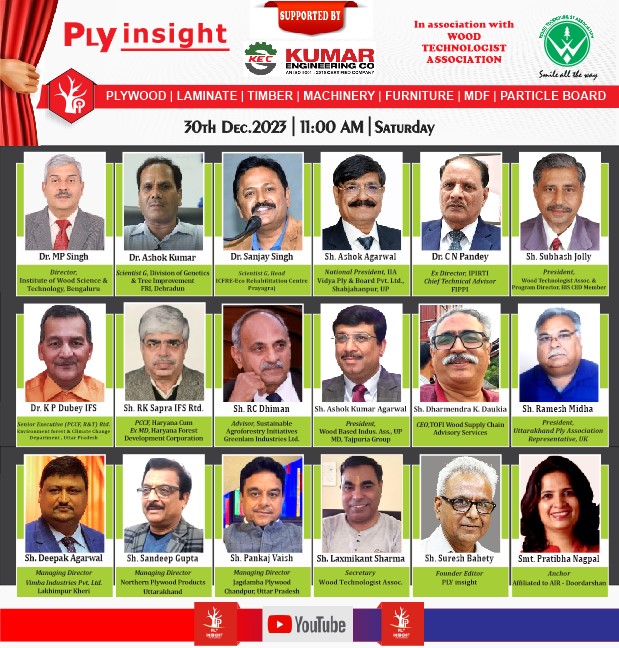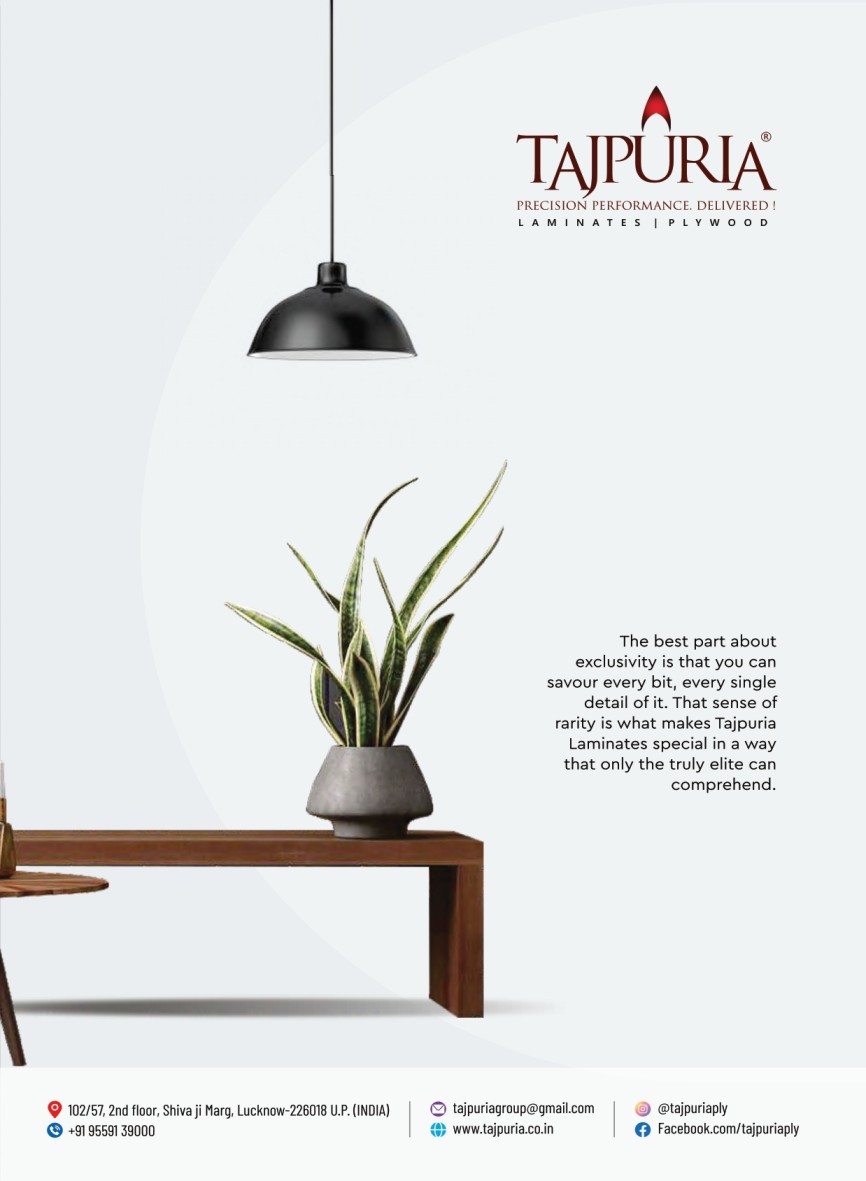
Agriwood Status in U.P. & Uttarakhand for Raw Material of WBI
- February 7, 2024
- 0
Suresh Bahety:
With introduction of new industrial policy either new units are nourishing or trend of further capacity increase are seen in Uttar Pradesh and Uttarakhand to rip the benefits of available resources.
That’s why own consumption of state is also increasing. In spite of the fact, still, it supplies poplar and eucalyptus to pan India.
Overall price increase in timber has also impacted the state’s own resources and industry is now felling the crunch.

MP Singh:
- UP and Uttarakhand can provide timber along with plywood to the entire country.
After the affirmative decision of the Supreme Court, there has been a new enthusiasm for the plywood industry in UP. The government is also encouraging new units. Now industrialists from other states are also moving to UP. There is ample potential for wood industry in Uttarakhand also. Such a system should be generated that this enthusiasm remains forever. For this, Wood Council or Wood Board should be established in which. CM should be the chairman in this. This will not only solve the problems of the wood industry but will also ensure regular availability of wood to the industries.
RK Sapra:
- Should an Agroforestry Board be created or State Wood Council?
MP Singh:
It depends on the states whether they form a board or a council. If the Agriculture Department forms it, then Agroforestry Board will be formed. If the Forest Department forms it, then Wood Council will be formed. Overall there should be a platform where everyone related to wood can express their views. Brain storning is going on for a national level board. If the Chief Minister is its president, then every people associated with wood and agriculture will participate in it. It should have regular meetings. Where further strategy can be tackled regarding the problems and suggestions, received.

RC Dhiman:
- CLC funds should be spent.
CLC funds should be spent on other wood related works and activities. Study and research can be done on wood. At present this fund can be spent only for plantation.
Ashok Aggarwal:
- On what basis is it being claimed that there is excess timber in UP?
I cannot understand how it has been assumed that there is enough wood in UP. In UP, wood is coming from Bihar. Imported timber is coming when the government opened the portal for setting up new units more than a thousand applications for license recieved from many districts. Because of this the government was forced to close the portal. I don’t think there is surplus wood in UP. The factories are running for eight to ten hours. But we will have to make efforts ourselves. Because wood is our basic need. We have planted the poplar sapling with our. We are satisfied own efforts with results.
New units are coming on while some others are shutting down. We have advised the government to provide good quality eucalyptus clone to the farmers. However, saplings are being planted, but there is a shortage of good quality timber. We have to pay more attention towards tree planting.
Currently the prices of plywood are decreasing; but the prices of wood is increasing. Due to this the industries are in great dilemma. Future may be troublesome. Because now the mdf units are also thriving in UP. Therefore, we all will have to work collectively to ensure that there is no problem of wood.
CN Pandey:
- Every state should make its own roadmap regarding wood.
We have to calculate and decide how much wood we have and how much we need. How many hectares we need for plantation? Which timber should go in mdf and which in plywood. How many hectares of Safeda or Poplar should be planted? Can the timber requirement be met by a four-year or five-year crop cycle?

Since we are talking about the quality of wood, we have to understand one thing that we cannot get good quality in plywood by peeling young trees i.e. three or four years old trees. That’s why we are importing wood from Brazil. So that by mixing both, we can get the required quality. Hence work should also be done on the quality of the raw material.
Every state should make its own road map regarding tree planting. Under ToFI, Funds are coming from US to Haryana and Punjab and also to UP. The association should decide how many hectares of saplings should be planted in the state. If the association sets its goals and achieves that goal we can discuss about it as a success story.
RC Dhiman:
- Diversion of wood to other states should be take care of.
There is no shortage of wood in UP, sixty percent of the wood comes to Haryana from UP. There is enough wood for the units in UP, but Haryana and other states purchase this wood at a higher price. Today wood is going out of UP. Tomorrow wood will start moving from any another place to other state.
Deepak Aggarwal:
- Strategy should be made keeping 2030 in mind.
Ashok Aggarwal rightly said that there is no doubt that we are facing shortage of wood. The availability of wood is still being assessed on the basis of 2010. While we are moving in 2024. Where production in factories is increasing and wood consumption is increasing.

Licenses are also being issued on regular basis. Therefore, we should evaluate the wood on today’s seenerio. Only then will we be able to move towards a definite solution regarding wood. We have to make a strategy keeping 2030 in mind.
RK Sapra:
- Wood producing farmers will have to pay good rates.
It can be understood from the example of Haryana that our assessment regarding wood is not correct.
Uttarakhand was the first state where licenses were issued. After this the process of granting license started in Haryana. While issuing the licenses, an effort was made to corelates the availability and supply of wood.
Licenses were issued in a similar manner in Punjab also. The state units are running at 25 percent capacity. The have labor problems also.
As far as transportation of wood to other states is concerned, farmers will take the timber where it will fetch a higher price.
Now the time is for only those units which will move carefully to survive in this race. The unit which does not utilize the raw material effectively may be out of the market.
As far as cutting of young trees is concerned, even the MDF is booming now. Why will a farmer keep the trees in the field for a long time, if he is getting so much value in a short period of time?
KP Dubey:
- A research model should be formed.
There was a demand for licenses of wood-based units in the state for a long time. This demand came from places where there where no wood based units. Today the demand for plywood is also increasing, and employment opportunities can also be created from wood based units. In views of this, licenses have been opened in UP. The government is trying to create employment opportunities in UP through the timber industry.
Today we will have to work certainly on zero waste formula. Only then can the unit survive. This is a big challenge. As far as production and supply of wood is concerned, there is no shortage of wood in UP. The wood is completely dependent on the market. The law of demand and supply works. It operates automatically in a natural way. In which we cannot interfere much. We can produce goodquality wood. A policy will have to be made for this. Now if the farmer wants to harvest timber early, we cannot stop him.
We should create such a model, a research center consisting of industry experts. Industry should provide financial help to them. Agriculture or horticulture or forest department and industry should come together on one platform. Agro forestry policy is being made in UP. Apart from this, a policy for wood base industry is also under process. Unless the industry comes forward, the goal of high quality wood cannot be achieved.

Poplar and eucalyptus were not encouraged in government nurseries in 2022. Therefore, we will have to do public private partnership or private nurseries of eucalyptus and poplar should be nurtured. Although under the ToFI Project, a nursery of one lakh plants is being built in Lucknow, a nursery of one lakh plants is being built in Bulandshahr. But this is not enough. To provide two crore or one crore good quality seeds or saplings in three parts of UP, the industry should also provide financial support for this.
RK Sapra:
- Timber rates are higher in Yamunanagar.
Because farmers are getting more price of timber in Yamunanagar. That’s why they brings wood to Yamunanagar.
Farmers bring wood to Yamunanagar despite facing all kinds of problems in transportation. There is only one reason, higher rates of wood.
RC Dhiman:
- All industrialists will have to work collectively for Nursery.
Industries should also be set up in those areas in UP where wood based units are less. Industrialists can be encouraged by giving subsidy on transportation.
UP is a big state, no attention was paid to nurseries here. All industrialists will have to work together for this. So that the demand for wood in UP can be met.
The private sector will have to make efforts for nurseries at their own level and collectively. Demand for plywood is going to increase in UP. Because there is still a lot of gap in development in the housing sector.
Ashok Tajpuria:
- Will distribute one plant against one ply.
We have provided wood to the entire country and will continue to provide wood in future also. I believe that plantation is going on rapidly in UP. Unless there is demand there will be no supply. If there is demand, it would definitely be produced. We have so many opportunities to make wooden products to supply in the country’s market and export as well. The government is also encouraging in this direction. The government had simplified the stringent rules.

We will have to solve the problems of farmers. Now we will have to make efforts at our own. The government is doing whatever it can. The licensing process became easier. It is not a matter of concern that wood is going to other states. If we will pay higher rates, we are not deprived of timber.
We are giving saplings to the farmers. Going to increase it further. Will distribute one plant against one ply. Our effort is that in two-three years we become so self-reliant in the wood sector that we do not have to bother about wood.
Sandeep Aggarwal:
- How do we get enough wood? Require guidance in this.
More Industries should come. The growth in the plywood unit creates an atmosphere. Still, we have to think that the supply of wood remains assured. How can we, with the help of government, ensure that the quantity of wood we need is available in the future?
Availability of timber should assessed have been carefully before issuing the license. There should have been a full study. Certainly, it is also the responsibility of the industrialists to pay attention to how the demand for wood is met.
When MDF plants are growing continuously in the country, we will have to be more attentive to get enough wood for the plywood. Most of our units are currently in unorganized sector like Small or MSME. How can we reduce the waste to zero? We don’t even have its model yet.
50 cft wood is consumed in one peeling. Future assessment can be made upon this. With the increased demand from MDF, farmers will cut young trees. Because of this, how will we get wood for the plywood unit.
What help can we take from the government in Uttarakhand. Currently, there is a lot of vacant land is lying in government domain. But there is doubt whether industrialists will get it for plantation.
Deepak Aggarwal:
- Do eucalyptus reduces water level?
A myth was expressed by the Forest Department regarding eucalyptus that it is spoiling the land. And this is having a huge impact on water level.
 Ashok Tajpuria:
Ashok Tajpuria:
- Such misconception should be opposed.
Eucalyptus does not spoil any land. Such misconceptions should be strongly opposed. I am a member of the Wood Based Industry, and also attend the SLC meetings, not even once did any such thing come from the government regarding eqcalyptus. Eucalyptus is not harmfull for water and land. This is a scientific fact.
Tajpuria:
- Industrialist should pay attention to Nursery.
As far as assessment is concerned. Once we do a study, we work on that assessment until further assessment is done. Licenses should not be withheld. The only solution is to increase the production of wood. We are now focussed to promote tree plantation. However, this has its own problems. So we chose a middle path.
We have experimented and we are continuously planting trees in the private sector. Any farmer who supply wood, we give him saplings. Every plant is planted somewhere in the ground. It is not wasted effort.
RC Dhiman:
- Eucalyptus is the most planted plant in India.
The government stopped plantation of eucalyptus and poplar because it affects the rates. Eucalyptus is the most planted plant in India.
RK Sapra:
- Right plantation should be done at the right place.
Farmer of Haryana has been planting eucalyptus for 50 years. Farmers of Haryana cultivate it a lot. This is a misconception spread that eucalyptus spoils the land. The right sapling should be planted at the right land. Its package and practice should reach the farmer. The industry should come forward to encourage Alanthus. And do more research in Alanthus in collaboration with FRI.

Dr. Sanjay Singh:
- The circumstances of Uttar Pradesh is scattered.
There is a need to look at Uttar Pradesh holistically. Due to the large area, the conditions here are scattered. Therefore, result of wood production also cannot be similar. It is a good sign that the industry wants to increase to the production of wood in UP. Timber production now needs to be looked at from an industrial perspective. Instead of depending on the government, industrialists should encourage it themselves.
There is a difference in the circumstances of Eastern Uttar Pradesh and western Uttar Pradesh. Eastern Uttar Pradesh is providing only 60 percent wood to the industry. There is also shortage of land. Farmers also do not have much enthusiasm about wood. The market has also disappointed the farmers. There is limited timber industry. The problem in eastern Uttar Pradesh is that there is no system in place to ensure that the farmers get the right price for the wood they are growing.
Farmers should have the option of cultivating different types of timber. The inclination of farmers towards Milia Dubia and Mahogany is also increasing. The industry will also have to come forward to accept such varieties. Its clones should be developed by the research center.
There is a increasing talk in Uttar Pradesh for green cover through plantation for the environment. But this is possible only if it increases the farmer’s income. For this we will have to develop the market.
Lakshmi Kant:
- There will be no shortage of wood.
When 40 thousand kilometers Haryana can become Asia’s largest market. We have about two lakh 43 thousand kilometers. Sixty percent of the wood in Haryana is coming from UP. We have fertile land.
The problem of the farmers is that when they do not get a fair price for the wood, they abandon its cultivation. This is a regwar cycle. Which comes after every five-six years. This sequence has been going on for 20 years. The wood from UP is going to Haryana as well as other states. As the factory is increasing, it is natural that there will be shortage of wood. After two years, new timber will be harvested, there is every possibility that the shortage of timber will be minimized.

We all should work together to ensure that farmers get a fair price for wood. So that he remains encouraged. Along with this, good quality plants should be provided to the farmers. We have no shortage of land. There is just a need to create a system to maintain the speed.
Sugarcane cultivation is more in UP, we also have to keep in mind that the wood producing farmers will have to be given such a rate that their income is not less in compare to sugarcane.
Dharmendra Daukia:
- Why is nursery not nurturing in UP?
Attention was never paid to nurseries in UP. The timber industry of Western UP is developing. Industries came first in Rampur. Ply industry is expanding to Sitapur, Sultanpur and Pratapgarh. Clones are coming to Rae Bareli from Andhra. Action Tessa has started a big nursery. Century is bringing the sapling from Andhra. Poplar in UP is coming from Uttarakhand.
Industries are nourshing here. That’s why more timber will be needed. Without nurseries we cannot grow wood in sufficient quantity. UP should have its own nursery. Collectively or individually Industrialists should pay attention to nurseries. We can build such nurseries in Rampur and Sitapur.
The government is promoting timber, but there is no commercial timber. The UP government should be proposed that the green cover campaign will be successful only if the commercial interest of wood is served in it.
There should be a change in the policy of the government to grow Safeda in its own nurseries. It is okay that they do not plant eucalyptus on government land, but farmers should be made provided saplings for planting. There is every possibility of increas in demand in UP, Saplings should be planted in a systematic way in UP.

Industrialists should invest one percent of their capital cost in nurseries another two percent for encouraging farmers. The quality of the plant should be enhanced. So that good quality wood is available. Because we can make better products only with quality raw materials.
Subhash Jolly:
- Conclusion of webinar.
Clusters should be formed to reduce logistics.
Eastern and Western Uttar Pradesh. Should have Separate clusters.
There should be state wood councils.
The number of nurseries should increase.
The quality of plants should be improved through research. Quality wood will be available only when farmers get good quality plants.
Sandeep Gupta:
The conclusion of the webinar was that the industry will have to encourage nurseries on its own.
Suresh Bahety:
Suggestion and proposal of Ashok Tajpuria that saplings should be given as ‘return gift’ in every timber trolley is noteworthy, commendable and important.
K P Dubey:
There has been discussion about nursery for the last three years. I call upon WBI to take concrete action on this and prepare a plan for a nursery of at least one crore plants and present it to the government.
The government will also pay attention to the fact that we should co-relate the plants grown by the industry with the environment.


































































